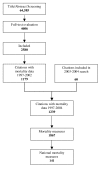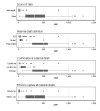National estimates for maternal mortality: an analysis based on the WHO systematic review of maternal mortality and morbidity
- PMID: 16343339
- PMCID: PMC1351170
- DOI: 10.1186/1471-2458-5-131
National estimates for maternal mortality: an analysis based on the WHO systematic review of maternal mortality and morbidity
Abstract
Background: Despite the worldwide commitment to improving maternal health, measuring, monitoring and comparing maternal mortality estimates remain a challenge. Due to lack of data, international agencies have to rely on mathematical models to assess its global burden. In order to assist in mapping the burden of reproductive ill-health, we conducted a systematic review of incidence/prevalence of maternal mortality and morbidity.
Methods: We followed the standard methodology for systematic reviews. This manuscript presents nationally representative estimates of maternal mortality derived from the systematic review. Using regression models, relationships between study-specific and country-specific variables with the maternal mortality estimates are explored in order to assist further modelling to predict maternal mortality.
Results: Maternal mortality estimates included 141 countries and represent 78.1% of the live births worldwide. As expected, large variability between countries, and within regions and subregions, is identified. Analysis of variability according to study characteristics did not yield useful results given the high correlation with each other, with development status and region. A regression model including selected country-specific variables was able to explain 90% of the variability of the maternal mortality estimates. Among all country-specific variables selected for the analysis, three had the strongest relationships with maternal mortality: proportion of deliveries assisted by a skilled birth attendant, infant mortality rate and health expenditure per capita.
Conclusion: With the exception of developed countries, variability of national maternal mortality estimates is large even within subregions. It seems more appropriate to study such variation through differentials in other national and subnational characteristics. Other than region, study of country-specific variables suggests infant mortality rate, skilled birth attendant at delivery and health expenditure per capita are key variables to predict maternal mortality at national level.
Figures




References
-
- Pregnancy is special. Safe Motherhood. 1998. p. 1. - PubMed
-
- Bank W. Millennium Development Goals http://www.developmentgoals.org/
-
- Maternal mortality in 2000: Estimates developed by WHO, UNICEF and UNFPA. Geneva, Switzerland, World Health Organization; 2004.
Publication types
MeSH terms
LinkOut - more resources
Full Text Sources
Medical
Research Materials

